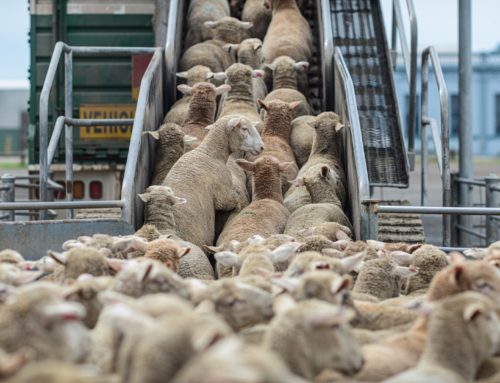Now I’ve been a staunch vegan and animal rights activist for going on half a decade, and many of the topics I research and write naturally fall under this category of topic.
That is to say that when I heard Netflix was a releasing a 90-minute documentary-exposé on the dark underbelly of the fishing and seafood industry, I largely expected to walk away angry and disheartened, but not necessarily shocked or surprised.
I couldn’t have been more wrong.
Not only is there something particularly harrowing about witnessing these horrific examples of industry-wide malpractice from the first person POV of director Ali Tabrizi, but the depth and scale of the government corruption and so-called “environmental advocacy” of world-renowned sustainability organizations that he uncovers left me speechless.
That’s why I guess it’s a good thing that I’m a writer and not a public speaker, because while I might not have a lot to say, I certainly have a lot that I want to type…
In This Article:
– Why Should I Care About The Ocean?
– Why Should I Care About Unprecedented Global Disaster?
– What Does Seaspiracy Have To Do With All This?
– What Can I Do To Help?
Why Should I Care About The Ocean?
You raise a fair question subtitle. Why should I (or anyone) care about the ocean?
I mean, personally I live in London and only manage to make it to the beach about once or twice per year; what’s in it for me to start focusing all my attention on trying to make it a better place?
Well for starters, all (and I mean all) environmental scientists worth their weight in gold agree on this one key thing: if the ocean dies, we die with it.
Here’s why:
Every year tiny organisms in the ocean called phytoplankton absorb over 4x the amount of carbon dioxide as the Amazon rainforest. In return, they contribute up to 85% of the total oxygen we breathe (1).
Now, these are two very important functions that exist on either side of the same coin. A coin that would result in unprecedented global disaster and destruction were it to stop spinning.
Why Should I Care About Unprecedented Global Disaster?
In 2019, the most comprehensive report, to date, was published on the subject of climate change by the United Nations Environment Programme and the Intergovernmental Panel on Climate Change (IPCC).
This 1,300 page publication was researched and written by 107 experts from 52 different countries who cited over 7,000 peer-reviewed studies; In other words, this report is the best thing we have in terms of accurately estimating the damage that has been done, and subsequently continues to be done, to our planet.
So what did it say exactly?
Well, it said a lot. But there are few main points that I’m hoping will really drive this whole caring about the environment point home for you.
By 2050, our world population is expected to hit over 9.8 billion, and by the same date the IPCC report warns that over 1 billion people will likely be displaced as a direct result of climate change (2).
This phenomenon is known as “climate migration,” and occurs when millions of people are displaced as a result of climate change effects such as shoreline erosion, floods, pollution, land degradation, droughts, food shortages, and natural disasters of all types. So if you think immigration is going badly now… just you wait (3).
It’s also important to understand that we’re not talking about a few unfortunate areas being affected, we’re talking about the entire world.
Current data suggests that the next few decades will bring about record levels of flooding, tropical storms, hurricanes, wildfires and temperatures that will continue to surpass the levels of the year before as time goes on (4).
These so called “natural disasters” will occur with an increasing frequency, and an unstoppable amount of force as a result of man-made conditions — conditions we continue to make worse.
Our oceans are on track to be fish-less by 2048, and the world will have only 60% of the water we need to survive by 2030. In this sense, 2050 will not mark the beginning of the climate disaster, it will mark closer to the end (5).
What’s further cause for alarm is that more recent reports have determined that the figures offered by the IPCC and similar academia have been “conservative in their projections of the impacts of climate change,” and that “at least some of the key attributes of global warming from increased atmospheric greenhouse gases have been under-predicted, particularly in IPCC assessments of the physical science (6).”
This means that the available reports on the subject of climate change have only estimated the “best case scenario” in an effort to avoid inflating the reality that we are currently proceeding towards a global disaster.
What Does Seaspiracy Have To Do With All This?
Okay so this documentary is good — real good. It’s so good in fact that I’m happy for you to pause your reading of this article, go watch Seaspiracy on Netflix, and then come back to me after to discuss.
So look, most of us are aware by now of the damage caused by non-biodegradable waste such as plastic bags, drinking straws, and un-recyclable single use packaging. We see it on the streets, we imagine it overflowing in our landfills — and, most importantly, we find it on the beach.
Not only do we find pieces of plastic trash buried in the sand along just about any coast in the world, but we also find them in the ocean, and, as a result, in the eyes, ears, noses, mouths, stomachs, and necks of our marine life.
In the Pacific Ocean, there is an area of 1.6 million km squared that is filled with over 79,000 tonnes of plastic known as the Great Pacific Garbage Patch.
This plastic isn’t just floating nicely on the top of the water like one might imagine, rather, it exists as a vortex of deadly debris miles upon miles under the surface, trapping and killing most all creatures unfortunate enough find themselves there.
The reason this patch of plastic is so treacherous is because contrary to popular belief, it’s not made up of plastic straws and discarded chip packets — in fact, only about 0.03% of this plastic waste comes from plastic straws.
A whopping 46% of the plastic trash (just think about that in comparison for a moment) comes from one source in particular — that is, fishing nets — with 70% of all micro-plastics in the ocean derived from dumped fishing gear (7).
You see, not only is it appalling that the majority of plastic pollution in the ocean comes from the practice of catching and killing creatures within said ocean, but these nets can take up to 600 years before they begin to break down and degrade.
And even when commercial fisherman aren’t selfishly abandoning their old or broken fishing gear into the water, they still contribute significantly to the destruction of marine life.
This is because for every 1 kilogram of fish caught by fishermen, up to 11 kilograms of unintended marine species (sharks, endangered sea turtles, dolphins, whales, seals, etc) are caught and discarded as “bycatch” or “by-kill” (8).
I mean, 300,000 dolphins and whales are killed by fishing operations per year.
And why should we care about the mass killing of marine life?
Well, do you remember those very important phytoplankton we discussed at the beginning of this article? The ones that are responsible for absorbing carbon dioxide and pumping out all the oxygen for us to breathe?
Well, without whales and dolphins and marine life around to play their equally important role in the ocean eco-system, these phytoplankton have no way of being fertilized, and cease to exist entirely.
So no whales and dolphins = no phytoplankton = no carbon sinks or breathable oxygen = no future we humans will have anything to do with…
ALL caused by fishing.
What Can I Do To Help?
So one way to stop killing marine life (and our planet in the process) is to stop paying fisherman to do it for us.
The fact is that if you were to quit eating fish right now, you would save the live of countless greater species of ocean life than if you were to go without using another piece of plastic for the rest of your life, and your grandchild’s life, and their grandchild’s life, and so on (9).
If you need more convincing than consider these stats courtesy of Seaspiracy:
- $35 billion in tax payer subsidies is given to the fishing industry every year. (The UN estimates that it would only take $30 billion per year to completely eliminate world hunger)
- Longline boats set enough fishing line in one day to wrap the circumferance of the earth 500 times over
- Bottom trawling for seafood releases as much carbon from the ocean floor as all air travel combined
- As it stands, fishing has wiped out over 90% of the world’s large fish
- Fishing is the single greatest threat to all marine life
So yeah…
If you haven’t already watched Seaspiracy, I highly recommend that you do.
This article only just scratches the surface of the environmental research we currently have, and the documentary itself covers (and uncovers) a wide range of other issues including ethics, human rights violations, conspiracy, and a far more extensive form of corruption than you might currently have the capacity to imagine.
“Some of the worst forms of human rights abuses are happening at sea right now, outside the jurisdiction of any country. It’s a wild and lawless place, and there are individuals and corporations who will do anything to either play down or keep a lid on their stories.” — Ali Tabrizi
Thanks for coming to my post-Seaspiracy article drop.
Text References:
- Basu, Samarpita; Mackey, Katherine R.M. 2018. “Phytoplankton as Key Mediators of the Biological Carbon Pump: Their Responses to a Changing Climate” Sustainability 10, no. 3: 869.
- UN DESA | United Nations Department of Economic and Social Affairs. (2017). World population projected to reach 9.8 billion in 2050, and 11.2 billion in 2100 | UN DESA | United Nations Department of Economic and Social Affairs.
- Myers, N. “Environmental refugees: An emergent security issue”, 13th Economic Forum, Prague, May 2005Intergovernmental Panel on Climate Change (2019).
- IPCC.Climate Change and Land: an IPCC special report on climate change, desertification, land degradation, sustainable land management, food security, and greenhouse gas fluxes in terrestrial ecosystems. SRCCL. IPCC (report) 2019.
- Brysse, K., Oreskes, N., O’Reilly, J., & Oppenheimer, M. (2013). Climate change prediction: Erring on the side of least drama? Global Environment Change, 23, 327–337.
- Lebreton, L., Slat, B., Ferrari, F. et al. Evidence that the Great Pacific Garbage Patch is rapidly accumulating plastic. Sci Rep 8, 4666 (2018).
- Lebreton, L., Slat, B., Ferrari, F. et al. Evidence that the Great Pacific Garbage Patch is rapidly accumulating plastic. Sci Rep 8, 4666 (2018).
- Fisheries and Aquaculture Department. “Discard and bycatch in Shrimp trawl fisheries.”
- Lebreton, L., Slat, B., Ferrari, F. et al. Evidence that the Great Pacific Garbage Patch is rapidly accumulating plastic. Sci Rep 8, 4666 (2018).





